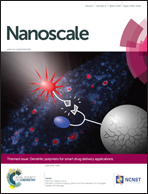Influence of inhomogeneous porosity on silicon nanowire Raman enhancement and leaky mode modulated photoluminescence†
Abstract
Metal-assisted chemical etching (MACE) offers an inexpensive, massively parallel fabrication process for producing silicon nanowires (SiNWs). These nanowires can possess a degree of porosity depending on etch conditions. Because the porosity is often spatially inhomogeneous, there is a need to better understand its nature if applications exploiting the porosity are to be pursued. Here, the resolution afforded by micro-Raman and micro-photoluminescence (PL) is used to elucidate the effects of porosity heterogeneity on the optical properties of individual SiNWs produced in large arrays with MACE, while also determining the spatial character of the heterogeneity. For highly porous SiNWs, there is a dramatic reduction in Raman signal and an increase in PL near the SiNW tips. PL spectra collected along the SiNW length exhibit peaks due to leaky mode resonances. Analysis of the PL resonance peaks, Raman spectrum line shape, SEM images, and EDS spectra indicate that the SiNWs possess both radial and axial heterogeneity wherein, from base to SiNW tip, the SiNWs comprise a shell of increasingly thick porous Si surrounding a tapering core of bulk Si. This work describes how structural porosity variation shapes SiNW optical properties, which will influence the design of new SiNW-based photonic devices and chemical/biological sensors.


 Please wait while we load your content...
Please wait while we load your content...